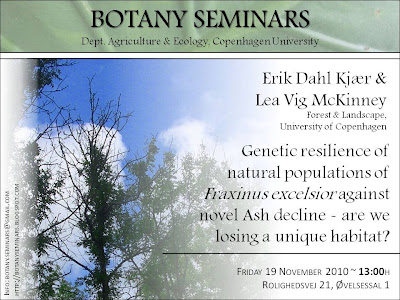
Genetic resilience of natural populations of Fraxinus excelsior L. against novel Ash decline - are we losing a unique habitat?
Lea Vig McKinney*, Lene Rostgaard Nielsen, Jon Kehlet Hansen, Lars N. Hansen, Iben M. Thomsen, David B. Collinge, Erik Dahl Kjær*
*Forest & Landscape, Copenhagen University
Fraxinus excelsior is an important tree species native to the Danish flora. It provides commercial and environmental services, and is a key-stone species in natural plant communities associated with moist forest habitats on fertile soils. However, the health and viability the species is presently threatened by a novel emerging disease, presumably caused by the fungus Chalara fraxinea. The disease was observed in Denmark in 2003, and has since become common throughout the country causing devastating harms.
Since 2007, we have studied genetic variation between Fraxinus excelsior trees of Danish origin in their susceptibility to the disease. By studying clone and half sib progeny trials 2007-2010, inferring from both natural and artificial infection, and using pedigree reconstructions based on SSR markers, we have established estimates of genetic variation and narrow sense heritability in degree of susceptibility. Our 5 years time series also allows us to assess the progression of the damage at the given sites. In 2010, we have initiated additional monitoring of damage level in five Danish Fraxinus stands with various ages, including the 100+ years old Stasevang stand.
In the presentation we introduce what is known about the disease, and provide a brief account of our main findings. Based on the findings, we speculate on the nature and degree (if any) of resistance and resilience to be expected in Danish Fraxinus stands due to inherent variation in susceptibility. Implications for the likely future of the Danish Fraxinus forests are discussed.
In the presentation we introduce what is known about the disease, and provide a brief account of our main findings. Based on the findings, we speculate on the nature and degree (if any) of resistance and resilience to be expected in Danish Fraxinus stands due to inherent variation in susceptibility. Implications for the likely future of the Danish Fraxinus forests are discussed.